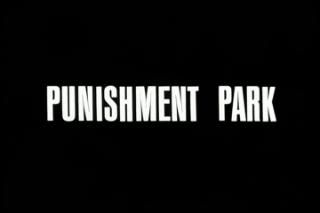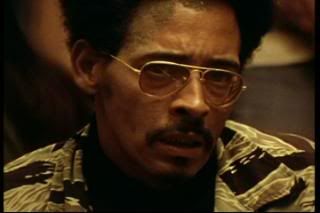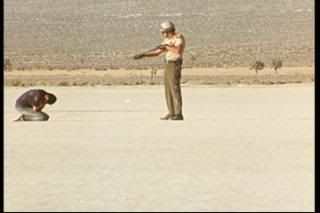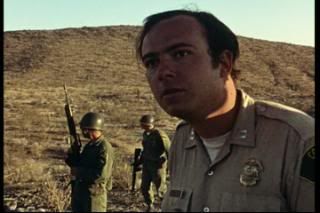
"You don't want to hear my message. You spent fifty years evolving a propaganda system that'll take the truth and change it into what you want to hear. You don't want to hear shit that's gonna mean you might have to give up something. You don't want it." Defendant Lee Robert Brown
In 1970, American citizens who are deemed a risk to internal security must face prison, or else take a chance in punishment park.
British filmmaker Peter Watkins’ faux-documentary, Punishment Park, stands out as a remarkable time capsule, a cultural relic from a bygone era. A scrolling narration at the start helps to situate the film by going over the landmarks in the American culture wars of the late 60s: Vietnam; the assassination of Robert F. Kennedy and Martin Luther King; the emergence of Richard Nixon; the 1968 Democratic Convention and the Trial of the Chicago Seven; the Kent State Massacre. By beginning with this laundry-list of civil unrest, from 1968 onward, Watkins anchors Punishment Park in the dying days of the radical era, when the country really was at war with itself.

Under the auspices of 1950 McCarran Internal Security Act, President Nixon sets up secret tribunals for trying and sentencing political radicals, Black Power activists, Leftists, hippies, and peaceniks. Under the letter of the law, these people are denied a trial by jury, and are denied the right to see the evidence against them. They are given the chance to speak for themselves, in a sort of kangaroo court officiated by conservatives, jingoists, and moralists, who shout down anything that the defendants try to say. In the end, the defendants are sentenced to a lengthy prison stay, or given the option of trying to survive three days in punishment park.
The ‘punishment park’ of the film is a desert in California. The radicals who choose punishment park over their jail sentence are given three days to travel over 50 miles with no water, and with cops hot on their heels. These parks have a duel purpose--they ease the burden on America’s overflowing prison system, and they help to train police for the likelihood of facing what seems to be never-ending civil disobedience in the cities. If the police catch a prisoner, they tell that prisoner that the game is over, and that they must now face their full jail sentence. If the prisoners resist, they will be met with force--often deadly.
Watkins filmed Punishment Park like a documentary, and on a shoestring budget. He filled the movie with non-actors who were real-life activists. He didn’t even put words into their mouth; every ideological position taken, every speech given by the defendants at their trial, are their own. To add to the authentic feeling of the film, the members of the tribunal act with extreme hostility to these unscripted appeals. Tempers flair, and each “trail” devolves into a shouting match. When ideologies clash, they rarely do so intelligently.

The film cuts between two separate groups of defendants. While a new group is shown trying to defend themselves in court, the group before them is shown trying to survive punishment park. This allows you to see what’s in store for the few characters who you are introduced to through the trials.
As I watched the film, I couldn’t help but think that the realism works against it. Why, if Watkins is attempting such realism, would he make up something like a punishment park? Certainly I’d be willing to believe detention camps and the like, but the idea that the government would make a game that the defendants could possibly win made no sense. Of course, as the film continued, my problem was solved: it becomes quite evident that no one survives punishment park. This makes the film all the more frustrating, since the defendants back at the court will eventually be allowed to choose between a definite jail sentence or what seems like a fair chance at escape by going through the park. Not much of a choice.
The film is very trying to sit through--at least not without clenching your fists in anger. The tribunal is filled with pigheaded men and women who aren’t really there to listen, only to condemn. Most of the defendants start out trying to speak intelligently, but they are battered down with a torrent of shouting, and with ridiculous claims, accusations that all they want is to turn America into one big orgy, or to blow up innocent women and children. The defendants, in turn, become more acidic in their defence, until their own words are just as vile and unintelligible. If someone is hoping that one of these defendants will provide a sensible and comprehensive argument, they’ll be let down. What they will discover, though, is that the two sides meet, in most instances, in their need to resort to violence. The radicals and revolutionaries on trial, and those in the park (save the pacifists), admit that they see no way to change America, or the world, short of violence. But they don’t have the power to do such a thing. The people of the tribunal, and the cops in the park, however, do, and their use of power is obviously an ugly one. The resort to violence, in the final instance, is the only thing that matters.

Watching Punishment Park today, I can’t help but feel that the film acts in a surprising new way; that is, it brings into stark relief the complete lack of a radical movement in today’s United States. Whether you agree with the positions taken by the defendants in Punishment Park or not, it seems remarkable that such people once existed. As clearly shown at Kent State and the 1968 Democratic National Convention, and in countless other instances, there was once a large and vocal breed of people willing to put life and liberty on the line to stand up for what they believed in. Today, with a worse president and even greater abuses of civil rights, that same movement is strangely absent. This isn’t to say that it’s gone altogether, but that someone is more likely to risk flame wars on blogs than to risk rubber bullets and tear gas when standing up for their beliefs. It's the difference between an age where Che Guevara was a radical and one where he's a popular logo.
In an essay the comes along with the DVD, Scott MacDonald points out that the full strength of the film is generally only felt when watched with a group who then discuss the film afterward. This is hardly surprising, since watching the film really made me want to discuss it with someone. One of the questions that always comes up in such situations, he says, is “There are no such things as punishment parks--are there?” This is always followed by two things: first, by someone assuring the questioner that, of course, there isn’t, and second, by someone claiming that this first person is naive to think so. The discussion that ensues ends up boiling down to whether or not America really is a great place to live, a moral and free country, and as temperatures rise the discussion dissolves into the sort of polemical, ideology-driven rants that comprise the film itself.
The Project X DVD comes in a full frame, 1.33:1 aspect ratio, and is accompanied with a host of features, including: a lengthy (28 minute) introduction by Peter Watkins, the aforementioned essay, audio commentary by a journalist named Joseph A. Gomez, a short film entitled “The Forgotten Faces,” the original 1971 press kit, and a Peter Watkins filmography. Anyone interested in alternative filmmaking, political film, or 60s radicalism should probably give it a go. Just don’t expect it to be pleasant.










1 comment:
So that was way longer than I intended it to be.
Post a Comment